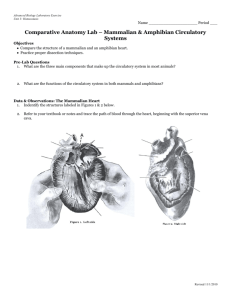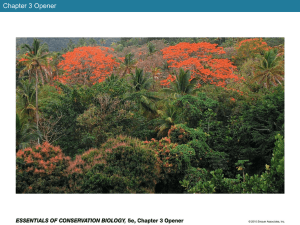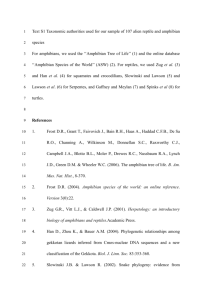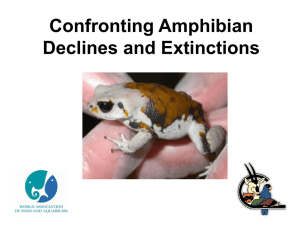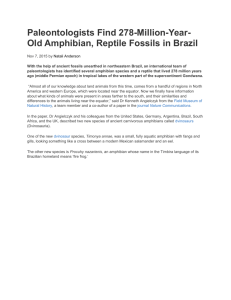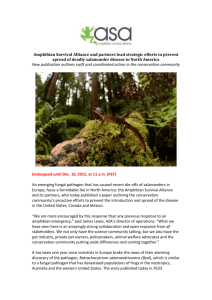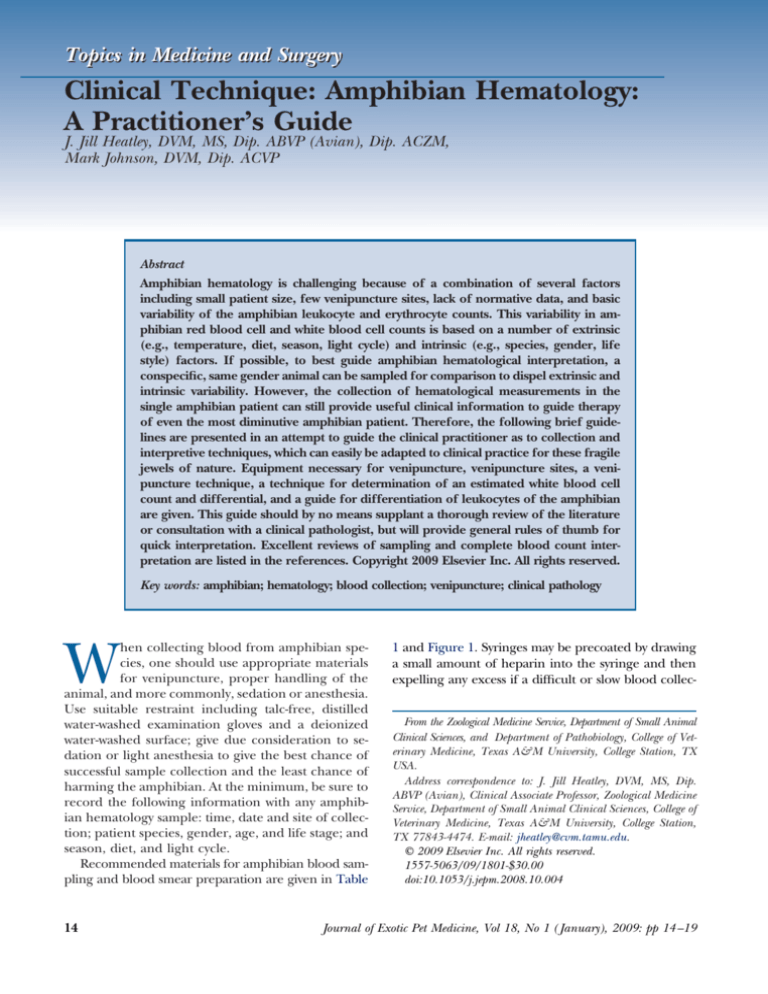
Topics in Medicine and Surgery
Clinical Technique: Amphibian Hematology:
A Practitioner’s Guide
J. Jill Heatley, DVM, MS, Dip. ABVP (Avian), Dip. ACZM,
Mark Johnson, DVM, Dip. ACVP
Abstract
Amphibian hematology is challenging because of a combination of several factors
including small patient size, few venipuncture sites, lack of normative data, and basic
variability of the amphibian leukocyte and erythrocyte counts. This variability in amphibian red blood cell and white blood cell counts is based on a number of extrinsic
(e.g., temperature, diet, season, light cycle) and intrinsic (e.g., species, gender, life
style) factors. If possible, to best guide amphibian hematological interpretation, a
conspecific, same gender animal can be sampled for comparison to dispel extrinsic and
intrinsic variability. However, the collection of hematological measurements in the
single amphibian patient can still provide useful clinical information to guide therapy
of even the most diminutive amphibian patient. Therefore, the following brief guidelines are presented in an attempt to guide the clinical practitioner as to collection and
interpretive techniques, which can easily be adapted to clinical practice for these fragile
jewels of nature. Equipment necessary for venipuncture, venipuncture sites, a venipuncture technique, a technique for determination of an estimated white blood cell
count and differential, and a guide for differentiation of leukocytes of the amphibian
are given. This guide should by no means supplant a thorough review of the literature
or consultation with a clinical pathologist, but will provide general rules of thumb for
quick interpretation. Excellent reviews of sampling and complete blood count interpretation are listed in the references. Copyright 2009 Elsevier Inc. All rights reserved.
Key words: amphibian; hematology; blood collection; venipuncture; clinical pathology
W
hen collecting blood from amphibian species, one should use appropriate materials
for venipuncture, proper handling of the
animal, and more commonly, sedation or anesthesia.
Use suitable restraint including talc-free, distilled
water-washed examination gloves and a deionized
water-washed surface; give due consideration to sedation or light anesthesia to give the best chance of
successful sample collection and the least chance of
harming the amphibian. At the minimum, be sure to
record the following information with any amphibian hematology sample: time, date and site of collection; patient species, gender, age, and life stage; and
season, diet, and light cycle.
Recommended materials for amphibian blood sampling and blood smear preparation are given in Table
14
1 and Figure 1. Syringes may be precoated by drawing
a small amount of heparin into the syringe and then
expelling any excess if a difficult or slow blood collecFrom the Zoological Medicine Service, Department of Small Animal
Clinical Sciences, and Department of Pathobiology, College of Veterinary Medicine, Texas A&M University, College Station, TX
USA.
Address correspondence to: J. Jill Heatley, DVM, MS, Dip.
ABVP (Avian), Clinical Associate Professor, Zoological Medicine
Service, Department of Small Animal Clinical Sciences, College of
Veterinary Medicine, Texas A&M University, College Station,
TX 77843-4474. E-mail: jheatley@cvm.tamu.edu.
© 2009 Elsevier Inc. All rights reserved.
1557-5063/09/1801-$30.00
doi:10.1053/j.jepm.2008.10.004
Journal of Exotic Pet Medicine, Vol 18, No 1 ( January), 2009: pp 14 –19
15
Amphibian Hematology
Table 1. Equipment necessary for amphibian hematological sampling
Equipment
Manufacturer
Comments
Accusure Insulin Syringe 0.3-0.5 mL
Qualitest Pharmaceuticals, Inc.,
Huntsville, AL
VWR Scientific Inc., Westchester, PA
Erie Scientific, Portsmouth, NH
Resco, Walled Lake, MI
Zero volume hub, attached needle 28
gauge, 1/2’’
“Cover slips” for blood smear prep
1.0-mm thickness
Removal of hub/needle of zero
volume attached needle syringes;
conserves sample volume
PCV and total solids determination;
may be used to create small drop
size to facilitate amphibian blood
smears
May be used to store hematologic
samples
Selected micro cover glasses
Gold Seal Rite-On Microscope Slides
Dog nail trimmers, guillotine style
Heparinized hematocrit tubes
Drummond Scientific Company,
Broomall, PA
Lithium heparin microtainers
Becton-Dickinson, Franklin Lakes, NJ
tion procedure is expected. Additionally, if sepsis is a
concern, consider reserving one drop of blood without
anticoagulant for placement onto a mini-tip culturette or
directly into an enrichment broth, which then should be
incubated at enclosure temperature. When collecting
blood for culture, aseptic technique, which includes adequate patient preparation and strict surgical preparation
of the skin to avoid culture contamination, is necessary.
Contacting the bacteriological laboratory for appropriate materials, such as pediatric blood culture vials, and
instructions for sample collection and storage should
occur before the procedure for best diagnostic results.
Although the collection of samples before antibiotic
administration is preferred in a patient where sepsis is
a concern, the collection of samples after antibiotic
administration is not contraindicated.
Methods of blood collection vary based on the species. Most commonly used venipuncture sites include
the ventral caudal tail vein, the ventral abdominal vein,
and the heart. Peripheral venipuncture may not require chemical restraint and may be performed in a
manner similar to that used on the tail vein of bovids
and as in reptilian species for the ventral abdominal
vein. For the abdominal vein or cardiopuncture, once
the animal is positioned appropriately, it is best to
visualize the venipuncture site. For the abdominal vein,
visualization may be aided by a bright, cool fiber-optic
light source to transilluminate the vein from the side or
behind or by ultrasound guidance. The ventral abdominal vein may be visualized without additional aids as it
courses down the ventral midline in amphibians with
minimally pigmented, translucent skin. The cardiac impulse can be visualized in some species without additional
aids. However, the dense skin pigmentation of many species necessitates the use of a Doppler flow probe (Fig 2),
ultrasound, or cool light transillumination to confirm the
blood flow in the heart or in other vessels before venipuncture. As in other species, cardiac puncture is not
without risk and should be performed only in an anesthetized animal with blood aspiration from the ventricle
with a small-gauge needle (Fig 3).
A small-gauge needle limits trauma to the amphibian and will not damage blood cells as long as minimal
aspiration pressure is applied. Use of an insulin syringe
with a zero volume hub also maximizes recovery of the
sample; however, the needle must then be removed for
s
Figure 1. Basic equipment for amphibian hematological sampling.
Pictured: Guillotine canine nail trimmers, 0.3-mL insulin syringe with
zero hub needle attached, slides, cover slips, heparinized PCV tubes,
and lithium heparin microtainers. Additional materials for restraint of
the amphibian are necessary (talc-free examination gloves washed
with distilled or deionized water, large dog mask for use as induction
chamber for isoflurane anesthesia, nonbleached paper toweling or
surface which has been moistened with distilled or deionized water).
16
Heatley and Johnson
For the leukocyte differential of amphibian blood
cells, a tabular (Table 2) and pictographic guide
(Figs 4-10) are given. Blood cells shown were obtained from Malaysian Horned Frogs (Megophrys nasuta) via cardiac venipuncture. Amphibian white
blood cells tend to vary considerably in morphology
and staining characteristics based on species. Therefore, these cells are presented only as a cursory
guide. One should consult additional texts for best
interpretation of amphibian leukocytes.1-3
Procedural Tip I
Calculation of the Appropriate Volume of
Blood to be Sampled from an Amphibian
The guidelines below calculate a minimum safe
blood draw. Conservative measures are used at each
step to safeguard patient safety.
Figure 2. Placement of a Doppler flow probe over the heart of a
Malaysian Horned Frog (Megophrys nasuta) to verify appropriate
venipuncture site.
sample processing. For needle removal, pull the sample to the back of the syringe and remove the needle
and hub with clean, sharp, guillotine-style dog nail
trimmers. This allows sample handling without having
to expel the blood through the small needle. Blood
may be used for fresh smears, culture, packed cell
volume, and total solids determination. Blood smears
may be made with a slide or cover slip technique. The
use of heparized hematocrit tubes may facilitate making the small drops necessary for good blood smears
when evaluating amphibian blood. The remainder can
then be placed in the lithium heparin microtainer for
separation of plasma and determination of blood
chemistries. Normal amphibian plasma varies with the
species and may be light blue, green, or orange. In the
amphibian, green plasma may or may not be due to
biliverdin elevations, and yellow or orange coloration
may be due to carotenoids or bilirubin elevations. Blue
plasma has been found in apparently healthy Japanese
giant salamanders (Andrias japonicus). The clinician
should exercise caution in the overinterpretation of
the plasma coloration in amphibian species as the
cause for coloration of serum or plasma, be it based
disease or completely normal, only has not been investigated in most species.1
●
Blood volume varies from 7% to 10% of body
weight in the terrestrial amphibian and 13% to
25% of body weight in the aquatic amphibian.
(Body weight, g)(0.07) ⫽ Minimal total blood
volume (TBV)
In the aquatic amphibian, the multiplication factor may be increased to 10% or 0.1.
●
Minimal safe blood draw (SBD) ⫽ 5% to 10% of
TBV
TBV (0.05) ⫽ SBD
In the healthy amphibian, SBD may be doubled.
●
For a 35-g sick frog, SBD:
35(0.07)(0.05) ⫽ 0.12 mL
Figure 3. Blood collection via cardiac venipuncture of a Malaysian
Horned Frog (Megophrys nasuta). This frog has been anesthetized
with isoflurane administered via face mask.
17
Amphibian Hematology
Table 2. Differentiation of common amphibian blood cells1,2
Cell Name*
Neutrophil
Heterophil (small
eosinophilic granule
leukocyte)
Relative Cell Size,
Shape, and Percentage
Predominant
inflammatory cell in
some species; visually
similar to mammalian
cell
30 to 32 m; larger
than that of
mammals; 1% to 33%
of leukocytes
Nucleus
Multilobed nucleus
Colorless cytoplasm, large
irregular granules with
slight eosinophilia or
only slight stain uptake
Round, multilobed nucleus
Colorless cytoplasm,
distinct eosinophilic,
rod-shaped, smaller
than eosinophil
granules; may
phagocytize bacteria
Small to medium, oval to
round eosinophilic
granules of variable
size
Basophilic granules round
to oval; often
degranulated by DiffQuik stain
Pseuodopodia may be
present, light blue-gray,
abundant cytoplasm
foamy or vacuolated;
occasional small,
irregular-shaped
azurophilic granules
(azurophils); may
phagocytize other cells
Scant, small amount, pale
blue to deep blue gray;
less cytoplasm with
more intense color than
thrombocyte
Eosinophil (large eosinophilic
granule leukocyte)
Same size or larger than
heterophil; 0% to 15%
of leukocytes
Smooth, less lobed
nucleus than heterophil
Basophil
Size variable; ⬍1% of
leukocytes of most
species; may
predominate in some
Similar in appearance to
mammalian cells;
usually larger than
granulocytes but
varies from smaller to
larger; 0% to 20% of
leukocytes
Nonsegmented, unlobed,
slightly eccentric, often
obscured by granules
Similar in appearance to
mammalian cells;
⬃50% of differential
in many species;
smallest leukocyte
(small lymphocyte)
more numerous than
large lymphocyte; 1/2
size of erythrocyte or
granulocyte
Oval to spindle shape;
cells tend to
aggregate
Larger than that of
mammals; oval cell
shape
Usually round but
occasionally cleft or
bilobed, nuclear
chromatin dense,
clumped
Monocyte/Azurophil
Small lymphocyte (large
lymphocyte)
Thrombocyte
Erythrocyte
Cytoplasm/Granules
Round, kidney, or
horseshoe shaped
Dense to round oval
Abundant colorless/pale
gray
Usually nucleated, nucleus
basophilic with bulge,
irregular nuclear margin
Deep eosinophilic (red to
pink)
*Cell name is based on amphibian cell staining characteristics and does not imply specific cell function or other similarity to mammal or other
vertebrate cells.
18
Heatley and Johnson
Figure 6. Blood smear from the terrestrial Malaysian Horned Frog
(Megophrys nasuta) stained with Diff-Quik shown at 1000⫻ magnification. The leukocyte shown is an azurophilic monocyte.
Figure 4. Blood smear from the terrestrial Malaysian Horned Frog
(Megophrys nasuta) stained with Diff-Quik shown at 1000⫻ magnification. The leukocyte to the left of the image is a neutrophil with
Döhle bodies, the leukocyte on top is a large lymphocyte with an
intracellular hemoparasite, and the small cell on the bottom is a
thrombocyte.
From a minute blood sample (0.1 mL), one can
examine for hemoparasites, perform an estimated
white blood cell count and a blood culture, and
obtain a packed cell volume and total solids deter-
Figure 5. Blood smear from the terrestrial Malaysian Horned Frog
(Megophrys nasuta) stained with Diff-Quik shown at 1000⫻ magnification. The eosinophil is the large cell with round cytoplasmic
granules. The remaining three leukocytes are small lymphocytes.
mination with a microhematocrit tube. Obtaining an
accurate white blood cell count with the help of a
hemocytometer requires only about 0.02 mL if the
blood is appropriately diluted with diluent/stain.
Procedural Tip II
Estimation of the Total White Blood Cell
Count and Determination of the
Differential Cell Count in an Amphibian
●
In the cell monolayer, count the number of
white blood cells in 12 high powered (400⫻)
fields.
Figure 7. Blood smear from the terrestrial Malaysian Horned Frog
(Megophrys nasuta) stained with modified Wright’s stain and shown
at 1000⫻ magnification. From the top proceeding clockwise, a small
lymphocyte, a thrombocyte, a neutrophil, and azurophilic monocyte
are shown.
19
Amphibian Hematology
Figure 8. Blood smear from the terrestrial Malaysian Horned Frog
(Megophrys nasuta) stained with a modified Wright’s stain and
shown at 1000⫻ magnification. From the top, leukocytes shown are
a monocyte, 3 aggregated thrombocytes, and a neutrophil.
●
Subtract the highest and lowest number fields,
then divide the remaining total by 10 to obtain X.
●
Multiply X by 1000. The final number is an estimate
of the amphibian total white blood cell count ⫽ LC.
●
To obtain a cell differential, count 100 white blood
cells to obtain a percentage of each white blood cell
Figure 10. Blood smear from the terrestrial Malaysian Horned Frog
(Megophrys nasuta) stained with Diff-Quik (Fisher Scientific, Pittsburg, PA USA) shown at 1000⫻ magnification. The central leukocyte
is a large lymphocyte.
type (see Table 2). Multiply each cell’s percent by LC
to give an estimated leukocyte count per cell.
Summary
Amphibian hematology is still in its infancy, and
sample collection and interpretation may be daunting to the general practitioner. This basic summary
reference guide was prepared to facilitate interpretation of the amphibian complete blood count for
the veterinary clinician. By making amphibian hematology interpretation more uniform and accessible, it
is hoped that the standard of amphibian medicine
will improve and that amphibian hematology will no
longer be regarded as a rare diagnostic procedure in
these patients. Hopefully, both amphibians and
mankind will benefit from this advancement.
Acknowledgments
The author wishes to acknowledge the assistance of
Dr. Sharman Hoppes for her contributions of figures
to this article.
References
1.
2.
Figure 9. Blood smear from the terrestrial Malaysian Horned Frog
(Megophrys nasuta) stained with a modified Wright’s stain and shown at
1000⫻ magnification. From the top, a basophil, a small lymphocyte, a
monocyte, another basophil, and an eosinophil can be seen.
3.
Campbell T, Ellis CK: Avian & Exotic Animal Hematology
and Cytology (ed 3). Oxford, Blackwell Ltd, 2007
Wright K: Amphibian medicine and captive husbandry, in Wright K, Whitaker B (eds): Amphibian
Medicine and Captive Husbandry. Malabar, FL,
Kreiger Publishing, pp 128-146, 2001
Pessier A: Cytologic diagnosis of disease in amphibians. Vet
Clin North Am (Exotic Anim Pract) 10:187-206, 2007



